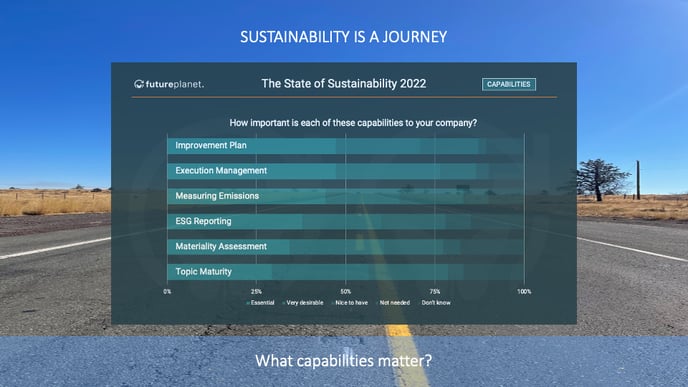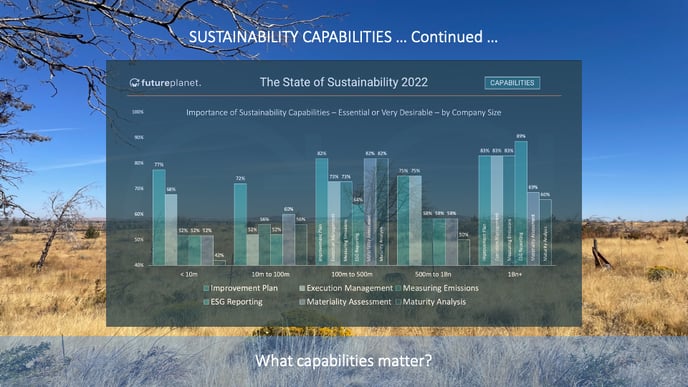What Materiality Topics Matter (Part 2/2)
[This was originally published as part of the Future Planet State of Sustainability Study. To request your copy of that report please email eva.] This is the second excerpt relating to Materiality Topics. You will find Part 1 here.
In many cases, good sustainability practices lead to better business practices. When corporations focus on only energy related emissions, they miss the avoided emissions from reduced waste, saved water, better procurement and more creative application of circular economy principles.
As you can see from this discussion, topics 4, 5, 7, 8, 9 on this list are very connected.
In some ways progress in Biodiversity is the bellwether of sustainability progress. It is noteworthy that it ranks here 10th in the list.
Think about this.
Biodiversity underpins the health of the planet and has a direct impact on all our lives. Put simply, reduced biodiversity means millions of people face a future where food supplies are more vulnerable to pests and disease, and where fresh water is in irregular or short supply. The main direct cause of biodiversity loss is land use change (primarily for large-scale food production) which drives an estimated 30% of biodiversity decline globally. Second is overexploitation (overfishing, overhunting and over-harvesting) for things like food, medicines and timber which drives around 20%.
In our study, less than one-third, just 29% of participants view Biodiversity / Land Use as Critical topics for their company.
Taking a bird’s eye view of the 10 sustainability topics in the table above, the analysis of the underlying data suggests that we can map the maturity or evolution of a company’s approach to sustainability as we progress from #1 Employee Health & Safety to #10 Biodiversity / Land Use. It varies by industry and company size of course, but novices tend to begin with topics with which they are generally familiar, like Employee Health & Safety and that’s often the best place to start. On the other hand, sustainability leaders, often with more resources, have greater ambition and/or a more sophisticated approach. This latter cohort already have initiatives in place for topics like Sustainable Procurement or Circular Economy Principles that reflect a recognition that there is a need to adopt a new way of doing business. Observationally, these progressive companies are already gaining a march and a competitive advantage in the market.
Other companies are struggling to put sustainability into context in their businesses.
Live. Buy. Design. Material topics in context
To make it easier for companies to consider how materiality topics apply across their business operations, companies might consider a structure that maps sustainability to how business operates – the Live Better, Buy Better, and Design Better methodology: living better in the business, buying better from suppliers, and designing better future products and services for market and customers.
Live Better is what happens within the four walls of a business, applying ethical business practices in the pursuit of sustainable profit and revenue growth, founded on inclusive principles and focused on reducing waste and emissions.
Buy Better addresses the interaction with the supply chain; sustainability impact is five to seven times greater from the supply chain than in a company’s business. Within Buy Better, companies can build an efficient, resilient and responsible supply chain which minimizes resource wastage, helping the suppliers to be part of the solution and an integral part of the sustainability strategy.
Design Better encompasses the interaction with customers and the delivery of products and services to the market. It mandates the designing of “better” products, thinking about the customers’ future, designing out waste and designing in circularity. In this way, a company can maximize reuse, and adhere to recyclable principles. Whole products or components thereof can then be repurposed to reenter the value stream prior to being disposed of responsibly.
All core materiality topics can then be mapped to Live. Buy. Design. on the horizontal axis against People (Social), Planet (Environmental) and Prosperity (Economic) on the vertical axis, all on a foundation of regulations (Governance) to put ESG in the context of the business.
This is how we suggest companies should think about sustainability more holistically.
This is the second of two posts on materiality topics. The first post is here.
You can review the Future Planet Materiality Assessment software here.
[This blog post was originally published as part of the Future Planet State of Sustainability Study. To request your personal copy of the study please email eva.]




